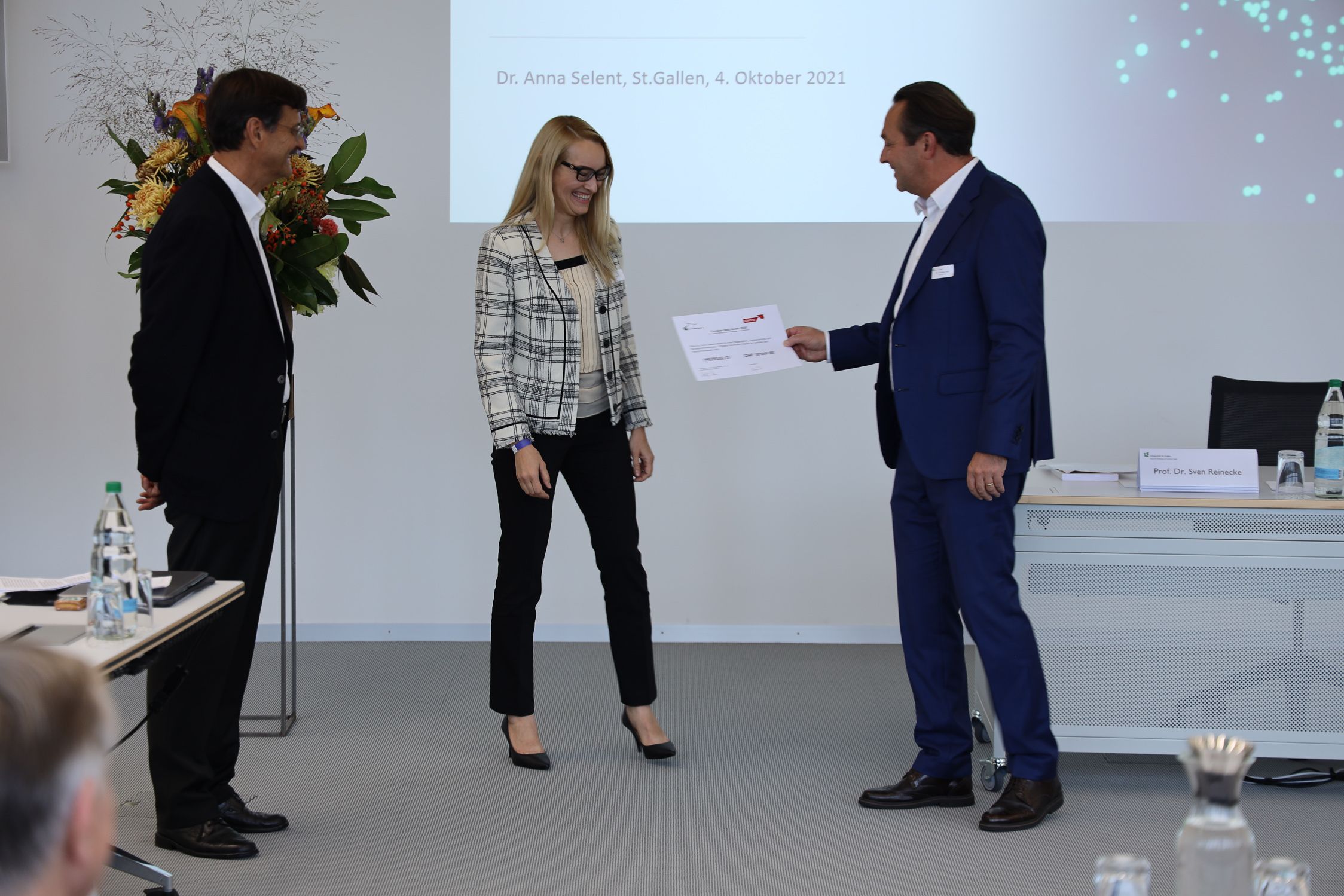Christian Belz Award for reality-oriented Marketing Management 2021
The Institute for Marketing and Customer Insight at the University of St.Gallen and the Starrag Group presented the second “Christian Belz Award for Reality-Oriented Marketing Management” to Anna Selent at the Marketing Dialogue on 4 October. The award honours the best dissertation of all marketing professors of the University of St.Gallen of the last two years for relevant, problem-oriented, substantial and innovative results. The prize is endowed with CHF 10’000. In addition to its technological innovation in the construction of machine tools, Starrag also promotes new forms of cooperation with customers in order to increase their benefits in a holistic manner.
In her research, Anna Selent looked at purchase-related digital customer interactions and their nodes in the industrial software industry environment and defined ‘digital interaction hubs’ as an innovative approach to marketing and sales in business-to-business markets.
The software buying process is characterised by the complex multi-stage decision-making process and a differentiated involvement of several people (buyer persona). The increasing digitalisation of the industry, the autonomous procurement of information by buyers and the later entry of sales representatives into the buying process weaken the influence possibilities and chances of success of personal sales. Digital customer interactions are gaining importance. The challenges are typical for many industrial markets.
With increasing use of internet technologies, further accelerated by the pandemic, buying processes are becoming even longer and more complex. The decision-makers involved, who have different objectives depending on their role, gather information independently and have to reconcile it with the group. Growing influence of Millennials – digital natives who have grown up with the internet and smartphones – significantly increases the digital part of this process. The digital buyer journey is becoming more and more complicated and less and less apparent as a process for the supplier. Suppliers often fail to reach buyers with relevant content. On the other hand, buyers experience a flood of information and find it difficult to find quality and trustworthy information to make an informed purchase decision. These realities are forcing sales and marketing teams to adapt the way they interact with the buyer in the buying process.
In her study, Anna Selent explored purchase-related digital interactions from the perspectives of the relevant buyer persona and the provider and analysed the online content of several software providers. She defines ‘digital interaction hubs’ as virtual places that have a high density of purchase-related interactions and that are internet-based communication, transaction and interaction centres. These allow the provider structured access to address the buyer’s information needs and interaction traits, to accompany him in his buyer’s journey and to positively influence him.
Buyer personas decide when and how they carry out their interactions, consume the content and interact with a provider. Mapping buyer journeys as a linear sequence of interactions, as in a script, and designing touchpoints based on that is therefore unrealistic. Therefore, providers should ensure that digital interaction hubs are designed to support flexible buyer journeys of all relevant buyer personas and navigate them to other relevant hubs, regardless of the order of the individual interaction steps. In this respect, ‘digital interaction hubs’ should form a kind of network that can be explored by buyers in a structured search or also in an occasional, sporadic search, so that they can start or resume their interactions or their buyer’s journeys independent of time and hub.ormation needs and interaction traits of the buyer, to accompany him in his buyer’s journey and to positively influence him.
In her dissertation, Ms Selent provides in-depth analyses of the buyer persona as well as the nine identified digital interaction hubs, describes their importance and use in the buying process and identifies their design options for optimal use in the sales process. Such ‘digital interaction hubs’ are ‘your business’, ‘customers who use it’, ‘why to buy’, ‘what to buy’, ‘explore and watch’, ‘let’s meet’, ‘ask the community’, ‘learn and get started’ and ‘try and buy’.
Focusing providers on these nine ‘digital interaction hubs’ enables them to reach the relevant buyer persona throughout the buying process, address their essential information needs and interaction preferences, and thus actively participate in the buying decision – regardless of when and how the buyer journeys.
Source: Selent, Anna: Digitalisierung von Kundeninteraktionen – ‘Digital Interaction Hubs’ im Vertrieb von Industriesoftware, Dissertation: St. Gallen 2019.

Further information:
Prof. em. Dr. Christian Belz, Institute for Marketing and Customer Insight at the University of St.Gallen, christian.belz@unisg.ch
Dr. Christian Walti (CEO), Starrag Group, media@starrag.com